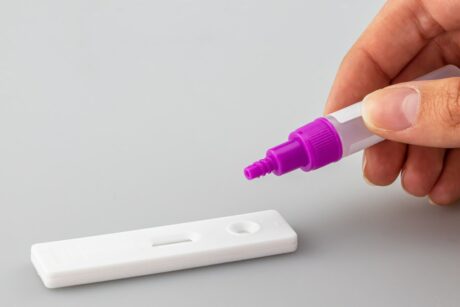The PCT value, also known as the procalcitonin value, is an important laboratory value that can be helpful in diagnosing bacterial infections and inflammation. Procalcitonin is a hormone that is normally present in low levels in the body, but increases during bacterial infections and inflammation. Therefore, an increase in PCT value may indicate a bacterial infection or inflammation.
What is the PCT Level used for?
The PCT value is mainly used for the diagnosis of bacterial infections and inflammations. An increase in PCT value can be an indicator of bacterial infection, while a low PCT value usually indicates a viral infection or other non-bacterial cause. The PCT value can also be helpful in monitoring the treatment of bacterial infections and inflammation, as a decrease in the PCT value may indicate successful treatment.
How is the PCT Level Determined?
The PCT value is determined by a blood test. A blood sample is taken and sent to a laboratory where the PCT value is determined and thus detectable in the blood. The results of the PCT test can be available within 24 to 48 hours.
PCT level table – what do the values mean
| PCT level (ng/mL) | Interpretation | Recommendations |
| < 0,05 | Normal range | No specific recommendations for action required |
| 0,05 – 0,5 | Slightly elevated, possibly due to bacterial infections or inflammation | Further testing and clinical evaluation recommended |
| > 0,5 | Highly elevated, indicative of severe bacterial infections or sepsis. | Immediate medical treatment required |
Please note that the interpretation of PCT levels can be complex and depends on several factors, such as the timing of the test in relation to possible symptoms. It is important that you speak with a physician to better understand and interpret the PCT test and its results. Depending on the cause and severity of the abnormality, treatment may be required to normalize the PCT level.
What do high and low PCT Values Mean?
A high PCT value may indicate a bacterial infection or inflammation, while a low PCT value usually indicates a non-bacterial cause or a viral infection. However, it is important to note that the PCT value is not the only diagnostic method and other tests must be performed to make an accurate diagnosis.
What are the limits for the PCT Value?
In general, a PCT value greater than 0.5 ng/mL is considered elevated and may indicate bacterial infection or inflammation. A low PCT value of less than 0.5 ng/mL is usually considered normal. However, it is important to note that exact limits may vary from laboratory to laboratory and a physician must evaluate the results of the test in conjunction with other diagnostic methods and clinical symptoms to make an accurate diagnosis.
What are the Advantages of the PCT Test?
The PCT test has several advantages over other diagnostic methods for bacterial infections and inflammation. One of the biggest advantages of the PCT test is its speed and availability. The PCT test can be performed within 24 to 48 hours, while other diagnostic methods, such as blood cultures, can take several days to provide results. In addition, the PCT test is easy to perform and requires only a single blood sample.
What are the Disadvantages of the PCT Test?
Although the PCT test has many advantages, there are also some disadvantages that need to be considered. One of the disadvantages of the PCT test is that it is not always reliable and false positive or false negative results can occur. A false positive result can lead to starting unnecessary antibiotic treatment, while a false negative result can miss a bacterial infection. Therefore, it is important for a physician to evaluate the results of the PCT test in conjunction with other diagnostic methods and clinical symptoms to make an accurate diagnosis.
Conclusion
The PCT value is an important laboratory value that can be helpful in diagnosing bacterial infections and inflammation. Although the PCT test has many advantages, there are also some disadvantages that need to be considered. Therefore, it is important for a physician to evaluate the results of the PCT test in conjunction with other diagnostic methods and clinical symptoms to make an accurate diagnosis.
PCT levels are most likely to increase significantly when an infection is caused by bacteria. This is particularly helpful in identifying a limited infection. In contrast, a low value may indicate the absence of a severe bacterial infection. Therefore, both elevated and low values are important indicators of the patient’s clinical picture.
If you are looking for PCT tests and other inflammation markers then you have come to the right place! Discover our assortment – Click here to go to our product categories.
FAQs about the PCT value
What does PCT Mean Anyway?
PCT stands for procalcitonin, a protein that increases in the body during bacterial infections and inflammation. The PCT value measures the concentration of procalcitonin in the blood.
When is the PCT Test Performed?
The PCT test is often performed in patients suspected of having a bacterial infection or inflammation. The test can be helpful in diagnosing and monitoring viral diseases and inflammation.
How is the PCT Test Performed?
The PCT test is performed by taking a blood sample and testing for the concentration of procalcitonin in the blood.
What does it mean if the PCT Level is Elevated?
Elevated levels may indicate a bacterial infection or inflammation. However, it is important to note that a physician must evaluate the results of the test in conjunction with other diagnostic methods and clinical symptoms to make an accurate diagnosis.
What does it mean if the PCT Value is Low?
A low PCT value is usually considered normal. However, it is important to note that exact limits may vary from laboratory to laboratory and a physician must evaluate the results of the test in conjunction with other diagnostic methods and clinical symptoms to make an accurate diagnosis.
Can the PCT Test Give False Positive or False Negative Results?
Yes, the PCT test can give false positive or false negative results. Therefore, it is important that a physician evaluate the results of the test in conjunction with other diagnostic methods and clinical symptoms to make an accurate diagnosis. Factors such as other diseases or medications may influence the PCT value and give false results.
Can the PCT Test be Helpful in Monitoring Bacterial Infections and Inflammation?
Yes, the PCT test can be helpful in monitoring bacterial infections and inflammation. An increase in PCT value may indicate worsening of the infection or inflammation, while a decreasing PCT value may indicate improvement. However, it is important to note that a physician must evaluate the results of the test in conjunction with other diagnostic methods and clinical symptoms to ensure accurate monitoring.
You may also be interested in




